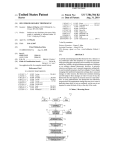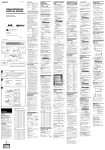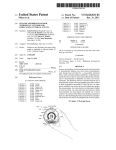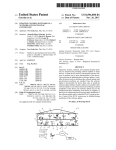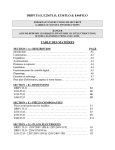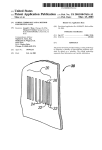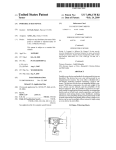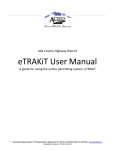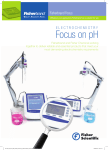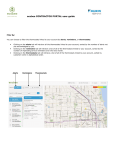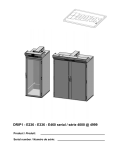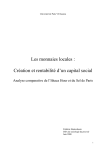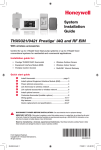Download 110/ BATTERY CIRCUIT \108
Transcript
USOO8754775B2 (12) United States Patent (10) Patent N0.: Holcombe (54) (45) Date of Patent: USE OF OPTICAL REFLECTANCE 3,991,357 A PROXIMITY DETECTOR FOR NUISANCE a N otlce: ' ZBI a 3/1981 Webb et a1. ................. .. 340/629 4,313,110 A * 1/1982 Wayne T. Holcombe, Mounta1nV1eW, 4,335,347 A 6/1932 Levine CA (US) 4,408,711 A 4,615,380 A 10/1983 Levine 10/1986 Beckey 4,674,027 A 6/1987 Beckey (73) Assignee: Nest Labs, Inc., Palo Alto, CA (US) * Is<ucllflrczy1< a 4,257,039 A _ Inventor: Jun. 17, 2014 11/1976 Kaminski 2 MITIGATION IN SMOKE ALARMS (75) US 8,754,775 B2 4,685,614 A 4,751,961 A s u bj ect to anyd'1sc 1 a1mer,t ' h etermo f t hi s 8/1987 Lev1ne 6/1988 Levine et al. _ patent is extended or adjusted under 35 (commued) U.S.C. 154(b) by 777 days. FOREIGN PATENT DOCUMENTS (21) App1.No.: 12/727,983 CA . 2202008 EP (22) F11ed: (65) Prior Publication Data US 2010/0238036 A1 Sep. 23, 2010 Subulak et a1. ............. .. 340/527 2/2000 196069 Mar. 19, 2010 12/1991 _ (Cont1nued) OTHER PUBLICATIONS Aprilaire Electronic Thermostats Model 8355 User’s Manual, Research Products Corporation, Dec. 2000, 16 pages. Related U_s_ Application Data (60) Provisional application No. 61/162,193, ?led on Mar. 20, 2009. (Continued) Primary Examiner * Steven Lim (51) Int“ Cl“ Assistant Examiner * Sisay Yacob (52) G083 17/10 U‘s‘ Cl“ (200601) (74) Attorney, Agent, or Firm *Kilpatrick Townsend & Stockton LLP USPC .... .. 340/629; 340/628; 340/630; 340/309.16; 73/2333; 73/2335; 73/35.01; 250/200; 250/554; 116/67 R; 116/101; 116/216 (58) Field of Classi?cation Search ABSTRACT USPC ,,,,,,,,,, ,, 340/6284630, 57 74584, 587, 309,16, detecting smoke and generating a detection signal responsive 340/527; 73/2333, 2335, 5301; 250/554, thereto. Proximity detection circuitry generates a proximity 250/200; 356/441; 1 16/ 101, 216, 67 R See application ?le for complete search history, detection signal responsive to detection of an object Within in a selected distance of the smoke alarm. Alarm generation circuitry generates an audible alarm responsive to the detec tion signal. The audible alarm may be deactivated for a pre determined period of time responsive to at least one proximity detection Signal' (56) References Cited U.S. PATENT DOCUMENTS 2,101,637 A 12/1937 Davis 3,934,145 A * 104 (57) A smoke alarm comprises smoke detection circuitry for \ 1/1976 Dobrzanski et al. ........ .. 250/381 14 Claims, 3 Drawing Sheets ALAR M IONIZATION SENSOR GENERATION SPEAKER C | RC U ITRY T E ST 110/ BATTERY CIRCUIT \108 / 106 US 8,754,775 B2 Page 2 (56) References Cited U.S. PATENT DOCUMENTS 4,857,895 4,897,798 4,975,684 5,088,645 5,211,332 5,240,178 5,244,146 5,250,904 5,395,042 5,476,221 5,499,196 5,555,927 5,611,484 5,801,625 5,808,294 5,902,183 5,909,378 5,918,474 5,977,964 6,062,482 6,066,843 6,095,427 6,098,893 6,111,511 6,216,956 6,349,883 6,356,204 6,370,894 6,415,205 6,478,233 6,619,055 6,645,066 6,769,482 6,990,821 7,024,336 7,109,879 7,149,729 7,188,482 7,379,791 RE40,437 7,469,550 7,579,945 7,623,028 7,644,869 7,702,424 7,784,704 7,802,618 7,848,900 7,854,389 7,994,928 8,010,237 8,016,205 8,019,567 8,037,022 8,090,477 8,091,375 8,098,166 8,131,497 8,174,381 8,180,492 8,219,249 2001/0038337 2004/0164238 2004/ 0249479 2005/0090915 2005/0128067 2005/0150968 2005/0189429 2005/0192915 2005/0280421 2006/0186214 2006/0196953 2007/0080819 2007/0115902 2007/0205297 > A1 A1 A1 A1 A1 A1 8/1989 1/1990 12/1990 2/1992 5/1993 8/1993 9/1993 10/1993 3/1995 12/1995 3/1996 9/1996 3/1997 9/1998 9/1998 5/1999 6/1999 7/1999 11/1999 5/2000 5/2000 8/2000 8/2000 8/2000 4/2001 2/2002 3/2002 4/2002 7/2002 11/2002 9/2003 11/2003 8/2004 1/2006 4/2006 9/2006 12/2006 3/2007 5/2008 7/2008 12/2008 8/2009 11/2009 1/2010 4/2010 8/2010 9/2010 12/2010 12/2010 8/2011 8/2011 9/2011 9/2011 10/2011 1/2012 1/2012 1/2012 3/2012 5/2012 5/2012 7/2012 11/2001 8/2004 12/2004 4/2005 6/2005 7/2005 9/2005 9/2005 12/2005 8/2006 9/2006 4/2007 5/2007 9/2007 Kaprelian Cler Guttinger et al. ........... .. 340/587 Bell Adams Dewolf et al. Jefferson et al. Salander et al. ............ .. 324/430 Riley et al. Seymour Pacheco Shah Uhrich Wang .......................... .. 340/ 506 Neumann D’Souza De Milleville Khanpara et al. Williams et al. Gauthier et al. Scheremeta Hoium et al. Berglund et al. Sivathanu et al. Ehlers et al. Simmons et al. Guindi et al. Thompson et al. Myron et al. Shah Addy Gutta et al. Wagner et al. Singh et al. Salsbury et al. Stults et al. Kaasten et al. Sadegh et al. Tamarkin et al. Rosen 2007/0266575 2008/0015742 2008/0183335 2008/0191045 2008/0273754 2008/0317292 2009/0171862 2009/0254225 2009/0259713 2009/0297901 2009/0327354 2010/0019051 2010/0025483 2010/0070084 2010/0070086 2010/0070234 2010/0084482 2010/0167783 A1 A1 A1 A1 A1 A1 A1 A1 A1 A1 A1 A1 A1 A1 A1 A1 A1 A1 2010/0179704 2010/0211224 2010/0238036 2010/0262298 2010/0262299 2010/0280667 2010/0289643 2010/0308119 2010/0318227 A1 A1 A1 A1 A1 A1 A1 A1 A1 2011/0046792 A1 2011/0046805 A1 2011/0046806 2011/0077896 2011/0151837 2011/0160913 2011/0185895 2011/0307103 2011/0307112 2012/0017611 2012/0065935 2012/0085831 Hoglund et al. Cannon et al. Harter Simon et al. Nash Kulyk et al. Poth et al. Harter Hick et al. Baker et al. Harrod et al. Boucher et al. Blumrich et al. Kilian et al. Resnick et al. Rosen Hoeynck et al. Steinberg et al. Harrod et al. Steinberg et al. Kennedy et al. Alameh et al. 7/2010 Ozog 8/2010 Keeling et al. 9/2010 Holcombe 10/2010 Johnson et al. 10/2010 11/2010 11/2010 12/2010 12/2010 Cheung et al. Steinberg Trundle et al. Steinberg et al. Steinberg et al. 2/2011 Imes et al. 2/2011 Bedros et al. 2/2011 3/2011 6/2011 6/2011 8/2011 12/2011 12/2011 1/2012 3/2012 4/2012 Nagel et al. Steinberg et al. Winbush, III Parker et al. Freen Cheung et al. BarrilleauX Coffel et al. Steinberg et al. Kopp 2012/0101637 A1 4/2012 Imes et al. 2012/0158350 A1 2012/0221151 A1 6/2012 Steinberg et al. 8/2012 Steinberg 2012/0252430 A1 10/2012 Imes et al. FOREIGN PATENT DOCUMENTS Chapman, Jr. et al. Richter et al. Kates A1 A1 A1 A1 A1 A1 A1 A1 A1 A1 11/2007 1/2008 7/2008 8/2008 11/2008 12/2008 7/2009 10/2009 10/2009 12/2009 12/2009 1/2010 2/2010 3/2010 3/2010 3/2010 4/2010 7/2010 JP JP JP 59106311 01252850 09298780 6/1984 10/1989 11/1997 OTHER PUBLICATIONS Steinberg et al. Ahmed Richmond Cheung et al. Drew Steinberg et al. Rahman et al. Steinberg Braeburn 5300 Installer Guide, Braeburn Systems, LLC, Dec. 9, 2009, 10 pages. Braeburn Model 5200, Braeburn Systems, LLC, Jul. 20, 2011, 11 pages. Ecobee Smart Si Thermostat Installation Manual, Ecobee, Apr. 3, 2012, 40 pages. Crawford Ecobee Smart Si Thermostat User Manual, Ecobee, Apr. 3, 2012, 44 Lang pages. Steinberg et al. Ecobee Smart Thermostat Installation Manual, Jun. 29, 2011, 20 Imes et al. pages. Steinberg Ecobee Smart Thermostat User Manual, May 11, 2010, 20 pages. Electric Heat Lock Out on Heat Pumps, Washington State University Harrod et al. Wickstead et al. .......... .. 340/628 Xu et al. Shorrock GeiwitZ Zakrewski Shearer Breeden Ahmed et al. Yomoda et al. Simon et al. Simon et al. Marks et al. ................ .. 340/628 Shamoon et al. Finkam et al. Extension Energy Program, Apr. 2010, pp. 1-3. Honeywell Installation Guide FocusPRO TH6000 Series, Honeywell International, Inc., Jan. 5, 2012, 24 pages. Honeywell Operating Manual FocusPRO TH6000 Series, Honeywell International, Inc., Mar. 25, 2011, 80 pages. Honeywell Prestige IAQ Product Data 2, Honeywell International, Inc., Jan. 12,2012, 126 pages. Honeywell Prestige THX9321 and TXH9421 Product Data, Honeywell International, Inc., 68/0311, Jan. 2012, 126 pages. Honeywell Prestige THX9321-9421 Operating Manual, Honeywell International, Inc., Jul. 6, 2011, 120 pages. Hunter Internet Thermostat Installation Guide, Hunter Fan Co., Aug. 14, 2012, 8 pages. US 8,754,775 B2 Page 3 (56) References Cited OTHER PUBLICATIONS Introducing the New Smart Si Thermostat, Datasheet [online]. Ecobee, Mar. 2012 [retrieved on Feb. 25, 2013]. Retrieved from the Internet: <URL: https://www.ecobee.com/solutions/home/smart-si/ >, Mar. 12, 2012, 4 pages. Lennox ComfortSense 5000 Owners Guide, Lennox Industries, Inc., Feb. 2008, 32 pages. Lennox ComfortSense 7000 Owners Guide, Lennox Industries, Inc., May 2009, 15 pages. Lennox iComfort Manual, Lennox Industries, Inc., Dec. 2010, 20 pages. Venstar T5800 Manual, Venstar, Inc., Sep. 7, 2011, 63 pages. VisionPRO TH8000 Series Installation Guide, Honeywell Interna tional, Inc., Jan. 2012, 12 pages. VisionPRO TH8000 Series Operating Manual, Honeywell Interna tional, Inc., Mar. 2011, 96 pages. VisionPRO Wi-Fi Programmable Thermostat, Honeywell Interna tional, Inc. Operating Manual, Aug. 2012, 48 pages. White Rodgers (Emerson) Model 1F81-261 Installation and Operat ing Instructions, White Rodgers, Apr. 15, 2010, 8 pages. White Rodgers (Emerson) Model IF98EZ-1621 Homeowner’s User Guide, White Rodgers, Jan. 25, 2012, 28 pages. Allen et al., “Real-Time Earthquake Detection and Hazard Assess ment by ElarmS Across California”, Geophysical Research Letters, vol. 36, LO0B08, 2009, pp. 1-6. LuX PSPU732T Manual, Lux Products Corporation, Jan. 6, 2009, 48 Deleeuw, “Ecobee WiFi Enabled Smart Thermostat Part 2: The Fea pages. tures NetX RP32-WiFi Network Thermostat Consumer Brochure, Net homenetworkenabled.com/contentphp?136-ecobee-WiFi-enabled work Thermostat, May 2011, 2 pages. NetX RP32-WiFi Network Thermostat Speci?cation Sheet, Network Thermostat, Feb. 28, 2012, 2 pages. RobertShaw Product Manual 9620, Maple Chase Company, Jun. 12, 2001, 14 pages. RobertShaw Product Manual 9825i2, Maple Chase Company, Jul. 17, 2006, 36 pages. SA720 Smoke Alarm User Manual, First Alert, Aug. 2007, 6 pages. Smoke Alarm User Manual, Kidde, i9060, Dec. 1, 2009, 2 pages. SYSTXCCUIZOl-V In?nity Control Installation Instructions, Car rier Corp, May 31, 2012, 20 pages. T8611G Chronotherm IV Deluxe Programmable Heat Pump Ther mostat Product Data, Honeywell International Inc., Oct. 1997, 24 pages. TB-PAC, TB-PHP, Base Series Programmable Thermostats, Carrier Corp, May 14,2012, 8 pages. The Perfect Climate Comfort Center PC8900A W8900A-C Product Data Sheet, Honeywell International Inc, Apr. 2001, 44 pages. TP-PAC, TP-PHP, TP-NAC, TP-NHP Performance Series AC/HP Thermostat Installation Instructions, Carrier Corp, Sep. 2007, 56 Review”, Retrieved from <URL: http://www. Smart-Thermostat-Part-2-The-Features-review>, Dec. 2, 2011, 5 pages. Gao et al., “The Self-Programming Thermostat: Optimizing Setback Schedules Based on Home Occupancy Patterns”, In Proceedings of the First ACM Workshop on Embedded Sensing Systems for Energy Ef?ciency in Buildings, Nov. 3, 2009, 6 pages. Loisos et al., “Buildings End-Use Energy Ef?ciency: Alternatives to Compressor Cooling”, California Energy Commission, Public Inter est Energy Research, Jan. 2000, 80 pages. Lu et al., “The Smart Thermostat: Using Occupancy Sensors to Save Energy in Homes”, In Proceedings of the 8th ACM Conference on Embedded Networked Sensor Systems, Nov. 3-5, 2010, pp. 211-224. Mozer, “The Neural Network House: An Environmental that Adapts to its Inhabitants”, AAAI Technical Report SS-98-02, 1998, pp. 1 10-1 14. Rauchwarnmelder, Installation and User Manual [online]. GIRA [retrieved on Mar. 8, 2013]. Retrieved from the Internet: <URL: http://download.gira.de/data2/23301210.pdf>. Rauchwarnmelder, Datasheet [online]. GIRA [retrieved on Mar. 7, 2013]. Retrieved from the Internet: <URL: http://www.gira.de/ pages. gebaeudetechnik/pro dukte/sicherheit/rauchmelder/ Trane Communicating Thermostats for Fan Coil, Trane, May 2011, rauchwarnmelderdualvds.html>, 14 pages. 32 pages. Rauchwarnmelder, Design [online]. GIRA [retrieved on Mar. 7, 2013]. Retrieved from the Internet: <URL: http://www.gira.de/ Trane Communicating Thermostats for Heat Pump Control, Trane, May 2011, 32 pages. gebaeudetechnik/pro dukte/sicherheit/rauchmelder/ Trane Install XL600 Installation Manual, Trane, Mar. 2006, 16 pages. Trane XL950 Installation Guide, Trane, Mar. 2011, 20 pages. rauchwarnmelderdualvds.html?vid:1145>, 7 pages. Venstar T2900 Manual, Venstar, Inc., Apr. 2008, 113 pages. * cited by examiner US. Patent Jun. 17, 2014 Sheet 1 0f3 US 8,754,775 B2 102 / 104\ 'OSNE'ilgggN ALARIVI GENERATION SPEAKER f106 CIRCUITRY TEST FIG. I 202 / 204\ gFE’L'ggF: ALARM GENERATION CIRCUITRY TEST FIG. 2 SPEAKER f206 US. Patent Jun. 17, 2014 Sheet 3 0f3 US 8,754,775 B2 ALARM 502 \ PROXIMITY CIRCUIT = MITIGATION FUNCTIONS ~ f504 BATTERY TEST \506 FIG. 5 TIT MONITOR FOR PROXIMITY ACTUATION DETECT ACTUATION ALTER ALARM TONE ALARM ACTIVATED PRIORITY DETECTED BATTERY DISABLE ALARM [610 f612 LOW ALARM PERFORM BATTERY 622/ ‘ BATTERY LOW INDICATION CHECK BATTERY LOW / 620 BATTERY OK 626/ I PERIOD Y EXPIRED INDICATION I FIG. 6 ENABLE ALARM \616 US 8,754,775 B2 1 2 USE OF OPTICAL REFLECTANCE PROXIMITY DETECTOR FOR NUISANCE MITIGATION IN SMOKE ALARMS alarm. This is of course a most irritating time for this to occur. Additionally, the beep is very dif?cult to locate since the beep is short and a single high frequency tone. The beep is short to CROSS-REFERENCE TO RELATED APPLICATIONS mostly depleted battery. The alert transducer uses a single high frequency, typically around 3 kilohertz due to the need to enable up to a week or more of low power battery alert on a produce a very high output from a small transducer which necessitates the use of a high frequency resonate transducer. Due to the re?ections and use of half wavelengths shorter than the distance between the human ears, it is very difficult to localize the source which may present a problem since most homes normally include a number of smoke alarms. Thus, there is a need to provide an improved method for temporarily mitigating an undesired activation of a smoke This application claims the bene?t of US. Provisional Application for Patent Ser. No. 61/162,193, ?led on Mar. 20, 2009, and entitled “USE OF OPTICAL REFLECTANCE PROXIMITY DETECTOR FOR NUISANCE MITIGA TION IN SMOKE ALARMS,” the speci?cation of which is incorporated herein by reference. TECHNICAL FIELD alarm and to provide battery check capabilities within the smoke alarm. The present invention relates to smoke alarms, and more particularly to smoke alarms including proximity detectors for controlling operation of the smoke alarm. SUMMARY 20 The present invention, as disclosed and described herein, in one aspect thereof, comprises smoke detection circuitry for detecting smoke and generating a detection signal responsive thereto. Proximity detection circuitry generates a proximity detection signal responsive to the detection of an object 25 within in a selected distance of the smoke alarm. Alarm BACKGROUND Smoke alarms are utilized for detecting and warning the inhabitants of a home or other occupied location of the exist ence of smoke which may indicate a ?re. Upon detection of the smoke by the smoke alarm, the device emits a shrill, loud generation circuitry generates an audible alarm responsive to the detection signal. The audible alarm may be deactivated for a predetermined period of time responsive to at least one alarm that noti?es all individuals within the area that smoke has been detected and departure from the premises may be necessary. While the smoke alarms are very effective at notifying proximity detection signal. 30 individuals of the possible existence of ?re that is generating the smoke, certain types of false alarm indications may often BRIEF DESCRIPTION OF THE DRAWINGS be very annoying to a user. These false alarms may be trig For a more complete understanding, reference is now made gered, for example, by smoke generation within the kitchen during preparation of a meal. This may cause the creation of to the following description taken in conjunction with the 35 enough smoke that will set off the smoke alarm causing the loud, shrill alarm. In this case, a ?re that is dangerous and out FIG. 1 is a block diagram of a ionization type smoke alarm; FIG. 2 is a block diagram of an optical type smoke alarm; FIG. 3 is a more detailed circuit diagram of an optical type of control is not of concern to the residents so the loud, shrill smoke alarm will provide more of an annoyance than a ben e?t. Presently, there exists no method for easily discontinuing the loud, shrill alarm other than farming the atmosphere in the smoke alarm; 40 present disclosure; FIG. 5 illustrates the various functionalities associated with the smoke alarm including proximity sensor modes of removing the battery or house power from the smoke alarm in 45 maximum smoke detection capabilities. An additional problem with existing smoke alarms is the DETAILED DESCRIPTION 50 Referring now to the drawings, wherein like reference numbers are used herein to designate like elements through out, the various views and embodiments of a smoke alarm that the battery has suf?cient charge. This often requires having proximity detection operation mode are illustrated obtaining a ladder or chair for the user to reach the smoke alarm which has been placed in a substantially high location 55 within the home or building to maximize smoke detection capabilities. The user is required to push a button that is located on the smoke alarm to perform a battery check. An audible signal is provided for an indication of whether or not the battery is in need of replacement. An additional related problem relates to the low battery 60 temperature is at a minimum and these conditions maximize the low battery condition and increase the likelihood of an and described, and other possible embodiments are described. The ?gures are not necessarily drawn to scale, and in some instances the drawings have been exaggerated and/or simpli?ed in places for illustrative purposes only. One of ordinary skill in the art will appreciate the many possible applications and variations based on the following examples ofpossible embodiments. condition within a smoke alarm. When the battery reaches a low power condition, the smoke alarm will commonly beep at a low duty cycle of around once per minute. Unfortunately, this beep often occurs in early morning hours when the house operation; and FIG. 6 is a ?ow diagram describing the operation of the smoke alarm including proximity sensor modes of operation. ing or other high area of the house or building to provide battery check or low battery condition. In smoke alarms that are powered by batteries, it is often necessary to periodically check the battery within the smoke alarm in order to con?rm FIG. 4 illustrates a block diagram of a smoke alarm includ ing proximity sensor operation capabilities according to the area of the smoke alarm in an attempt to remove the smoke from the area that is causing the smoke alarm to activate or order to turn it off. Removal of the power source may be dif?cult as smoke alarms are usually mounted upon the ceil accompanying Drawings in which: 65 Referring now to the drawings, and more particularly to FIG. 1, there is illustrated a functional block diagram of a ?rst type of smoke alarm. The smoke alarm of FIG. 1 utilizes ionization detection to detect smoke. The alarm generation circuitry 102 is associated with an ionization sensor 104. The ionization sensor 104 detects particles of smoke using a small US 8,754,775 B2 3 4 amount of radioactive americium 241. The radiation gener inactive. When there is suf?cient smoke to mask the light from the lamp 304 falling on the LDR 302, the LDR 302 ated by the americium 241 passes through an ionization chamber within the ionization sensor 104. The ionization chamber comprises an air-?lled space between two elec trodes that permit a small constant current between the elec resistance increases and so does the voltage across the LDR. This will cause the voltage at the gate of transistor 308 to increase and turn on transistor 308. This provides a voltage to power circuit 310 which generates a 5 volt signal to a tone trodes. Any smoke that enters the chamber absorbs the alpha particles emitted by the americium 241 which reduces the ionization and interrupts the current between the electrodes. generator 312. The tone signal from tone generator 312 is ampli?ed by an ampli?er 314 which is used to drive the speaker 306. Diodes 316 and 318 are used to drop the voltage input to the tone generator 312 from the power circuit 310. When this condition is detected, the ionization sensor 104 generates an alarm signal to the alarm circuitry 102 that generates an audible alarm signal that is provided to the speaker 1 06. Associated with the ionization type smoke alarm Referring now to FIG. 4, there is illustrated a block dia gram of a circuit which enables a user to utilize proximity is test circuitry 108 that enables testing of the present charge level associated with the battery 110. The battery 110 pro detection circuitry for temporarily abating an undesired alarm or performing battery test operations rather than using previ ously described processes. While the implementation with vides power to the ionization sensor 104, alarm generation circuitry 102, speaker 106 and test circuit 108 to power the smoke alarm. Referring now also to FIG. 2, there is illustrated an alter native type of smoke alarm circuitry comprising an optical smoke alarm. The optical smoke alarm also includes alarm generation circuitry 202 that is responsive to smoke detection signals provided by an optical sensor 204. The optical sensor 204 includes a light sensor that includes a light source which may comprise an incandescent bulb or infrared LED, a lens to collimate the light into a beam and a photo diode or other photoelectric sensor for detecting light from the light source. In the absence of smoke, the light passes in front of the detector in a straight line. When smoke enters the optical chamber of the optical sensor 204 across the path of the light beam, some light is scattered by the smoke particles redirect ing them at the photo diode or photo sensor, and thus trigger ing generation of an alarm signal to the alarm circuitry 202. The alarm generation circuitry 202 will generate the audible alarm signal to the speaker 206 associated with the alarm circuitry 202.As with the ionization circuit, the optical smoke respect to FIG. 4 describes the use of proximity sensor cir cuitry 402 within an optical type smoke alarm, the proximity 20 operate in a similar manner to the optical alarm described previously. Alarm generation circuitry 404 generates alarm signals to a speaker 406 responsive to smoke detection signals received from optical sensor 408. The optical sensor 408 25 with respect to the optical smoke alarm of FIG. 2. The optical sensor 408 in addition to detecting smoke is used for detecting the proximity of a user’ s hand or other item 30 prises a short-range (approximately 6 inches) optical proxim 35 alarm with either the wave of a hand or some other readily enables testing of the charge within a battery 412. The battery 40 45 easily check the battery charge using the test circuitry. Pres ently, mitigation of an alarm requires disconnection of the power source to the smoke alarm in order to discontinue an 50 since either removing power sources to discontinue an undes cate a ?re or emergency condition has been created. The 55 proximity sensor of the smoke alarm is activated when an object such as a hand or a broom is brought close to the optical sensor 408. If the smoke alarm has been activated due to kitchen smoke or other situations that have been resolved by 60 user to disable the smoke alarm for a short period of time, such as 3 minutes, to allow the area around the smoke alarm to air out. A double wave or other more complex detection by the proximity sensor circuitry 402 and optical sensor 408 may be accomplished in a short period of time, such as less than 10 tions require the user to get out a ladder or stand on a chair to access the smoke alarm placed in a high location to ensure its optimal performance. human intervention, proximity detection would enable the FIG. 3 illustrates a schematic diagram of an optical smoke duces an audible alarm from speaker 306 when smoke is detected. When there is no smoke, the light from the lamp 304 falls directly upon the LDR 302. The LDR resistance will be low, and the voltage across the LDR will be below 0.6 volts. Transistor 308 will be turned off in this state and the circuit is the smoke alarm may provide a number of proximity control ler functionalities. These are generally illustrated in FIG. 5. A number of proximity controlled functions 502 may be pro vided using the proximity sensor 402. The proximity con trolled functions include the alarm mitigation function 504 and the battery test function 506. The alarm mitigation func tion 504 enables a temporary discontinuation of the audible alarm in situations when an undesired activation of the alarm has occurred. This would occur for example, when a small amount of smoke created within a kitchen that does not indi the smoke alarm that requires the user to be able to physically touch the smoke alarm. This often presents a great challenge detection alarm based upon an LDR (light detecting resistor) 302 and lamp 304 pair for sensing smoke. The alarm works by sensing the smoke produced during a ?re. The circuit pro 412 provides power to each of the components within the smoke alarm circuit. Utilizing a combination of the proximity sensor circuitry 402, optical sensor 408 and alarm generation circuitry 404, heating element of the oven, etc., or the ability to quickly and ired alarm or pressing a button to perform battery test opera ity sensor that in conjunction with the proximity sensor cir cuitry 402 may be used to control operations of the smoke available object such as a broom. The test circuitry 410 As described previously, some issues arising with existing smoke alarms, be they ionization or optical type smoke alarms, arise from the creation of false alarm situations such undesired alarm. Additionally, any type of test of the battery charge requires pushing of a button on the external surface of in conjunction with the proximity sensor circuitry 402. The proximity sensor circuitry 402 detects when a hand or for example, a broom or other item are being waved in close proximity to the smoke alarm. The optical sensor 408 com 210. The battery 210 is responsible for powering all of the components of the optical smoke alarm including the alarm circuitry 202, optical sensor 204, speaker 206 and test circuit as, for example, when a small amount of smoke is created within the kitchen due to burning toast, food falling on the generates the smoke detection signal to the alarm generation circuitry 404 in the same manner as that described previously alarm utilizes a test circuit 208 to test the charge on the battery 208. sensor circuitry 402 could also be implemented within the ionization type circuitry described hereinabove. The smoke alarm detection capabilities of the smoke alarm of FIG. 4 65 seconds in order to enable assurances that the detection was for a desired mitigation of the alarm and not some type of random event occurring during actual smoke detection. US 8,754,775 B2 5 6 In order to assist a user in temporarily mitigating the alarm, a momentary change in the audible alarm would be desirable one for proximity detection and the other for smoke detection within the optical sensor 408. A light pipe can provide a signal from the baf?ed smoke detector and also from the outside for each proximity event that has been detected by the optical sensor 408 and proximity sensor circuit 402. This would proximity view. Depending on which LED is driven, the assist the user in knowing whether they had accurately or proximity detector is either for re?ectance above a threshold for either the proximity detection or for smoke and of course giving a different alarm response. Optionally, an auxiliary photo diode can be used for the smoke detector portion to avoid artifacts or issues arising from ambient light. Because inaccurately waved their hand or broom in the area of the smoke alarm and provide for an audible indication of aiming feedback with respect to the proximity detection. After the appropriate combination of proximity detection events have been detected by the optical sensor 408 and proximity sensor circuit 402, the audible alarm would be temporarily discon tinued. The smoke alarm commonly beeps at a low duty cycle of around once per minute when the battery 412 has its charge fall below a predetermined level. These beeps can often be very di?icult to locate since the beep is short and comprises a single high frequency tone. The beep is short to enable up to the proximity detection technology uses a low duty cycle controller to make proximity detection measurements every second or so, this low duty cycle controller can also be used for the low duty cycle smoke controller which is bene?cial for reducing battery charge consumption. Referring now to FIG. 6, there is illustrated a ?ow diagram describing the operation of the proximity detection controlled a week or more of low battery alerts to be created on an almost depleted battery. The alert transducer uses a single high fre quency chirp typically around 3 kilohertZ due to the need to produce a very high output from a small transducer. This necessitates the use of a high frequency resonate transducer. Due to the re?ections and the use of a half wavelength shorter than the distance between the human ear, it is often very dif?cult to locate the source requiring the user to check each smoke alarm within the house requiring a great deal of time. 20 Once a proximity actuation is detected, inquiry step 606 determines if the smoke alarm is presently activated. If so, control passes to inquiry step 608 which determines if a 25 The battery test functionality 506 enables a battery test operation to be performed on the battery 412 within the smoke alarm without having to manually press a button on the smoke alarm. The battery test functionality 506 can be uti predetermined number of proximity activations have been detected. If not, the alarm tone provided by the smoke alarm may be altered at step 610 and control returns back to step 602 30 lized in two situations. When a low battery charge chirp is being emitted by the smoke alarm, the low battery test func tionality 506 may be used to determine whether a particular smoke alarm has a low battery charge or whether the battery presently has su?icient charge. The battery test functionality 506 would similarly be useful for performing the periodic smoke alarm. Initially, at step 602, the optical sensor 408 and proximity sensor circuitry 402 monitor for a proximity actua tion. Inquiry step 604 determines whether there has been a detection of a proximity actuation. If not, control passes back to step 602 to continue monitoring for a proximity actuation. 35 to continue monitoring for additional proximity activations. If inquiry step 608 determines that a predetermined number of proximity actuations have been detected, the smoke alarm is disabled at step 612. Inquiry step 614 monitors for the expiration of a selected period of time. If the period of time has not yet expired, the process remains at inquiry step 614. Once the predetermined period of time has expired, control passes to step 616, wherein the smoke alarm is re-enabled and battery charge tests that are required to ensure the smoke control passes back to step 602 to continue monitoring for proximity actuation. Once the alarm is re-enabled, the smoke alarm is in working operation. By utiliZing the proximity sensor circuitry 402, if the detector can monitor for smoke and react accordingly. If inquiry step 606 determines that the smoke alarm is not dying battery. If the battery 412 is suf?ciently charged, a presently activated, control passes to inquiry step 618 to make a determination if the battery low alarm is presently active for the smoke alarm. If so, a battery low indication is audibly provided from the smoke alarm at step 620. If the battery low alarm has not been activated, a battery charge check is per formed at step 622. Inquiry step 624 determines whether the battery is in a low charge condition. If not, a battery OK single short beep of a different tone may be created. Thus, if audible indication is provided at step 626 to indicate a su?i a user hears a low battery beep, they can use their broom or cient charge and control passes back to step 602. If inquiry step 624 determines that the battery is in a low charge condi tion, the battery low indication is provided at step 620 before smoke alarm has not been activated to indicate detection of smoke, the detection of a single proximity event from a hand or broom by the optical sensor 408 and proximity sensor circuitry 402 initiates a battery check test. If the battery 412 is weak, the test circuitry 410 will cause the production of a 40 distinctive series of beeps or a distinctive tone to indicate a 45 hand to quickly and easily check all of the smoke alarms within their home without having to climb up on a chair or ladder or remove the devices in order to press a detection button upon the smoke alarm. As described previously, smoke alarms generally use either an ionization chamber or optical smoke detection circuitry or a combination of both to detect smoke. These differing tech 50 control passes back to step 602 to monitor for additional proximity actuations. The above-described solution provides a low cost intuitive 55 niques have distinct advantages and disadvantages. However, a high performance optical re?ective detector implemented within the circuit of FIG. 4 including proximity sensor cir cuitry 402 can readily be adapted to detect re?ectance from smoke and to provide proximity detection data since both detections are equivalent low re?ectance functions. The prox imity detector is more sophisticated since it must deal with improves safety since users often remove batteries or take down smoke alarms that are producing spurious alarms or low battery beeping alarms. Users will also take down unaffected 60 ambient light while the conventional optical smoke detector does not have to cancel ambient light since it looks for re?ec tions from smoke in an optically baf?ed compartment which blocks out ambient light but allows the entry of smoke. A re?ectance proximity detector can drive two different LEDs, battery alarm control system to limit nuisance alarms within the smoke alarm and enables ease of battery charge checking using a proximity detection control process. The system also smoke alarms since the user cannot localize the beep associ ated with the alarm and then do not replace the alarm. Con sumers do not check battery levels if the smoke alarm is out of reach. Additionally, use of an optical re?ection proximity control system is better than a capacitive proximity system 65 since convenient hand extension devices such as brooms would not work to activate a capacitive sensor which senses a conductive object such as the human hand or body. US 8,754,775 B2 8 7 It will be appreciated by those skilled in the art having the bene?t of this disclosure that this smoke alarm having prox imity detection operation mode provides an improved method for controlling operation of a smoke alarm. It should be understood that the drawings and detailed description herein determined period of time and within the selected dis tance of the smoke detector and while detecting the smoke. 7. The method of claim 6, further comprising: reactivating the audible alarm after another predetermined period of time when the smoke is still detected by the are to be regarded in an illustrative rather than a restrictive smoke alarm. manner, and are not intended to be limiting to the particular forms and examples disclosed. On the contrary, included are 8. The method of claim 6, further comprising: detecting movement of the object within the selected dis any further modi?cations, changes, rearrangements, substi tutions, alternatives, design choices, and embodiments appar tance when an audible alarm is not being generated; determining a charge level of a battery associated with the smoke alarm responsive to the detected movement; generating a ?rst audible indication when the charge level of the battery exceeds a predetermined level; and generating a second audible indication when the charge level of the battery falls below the predetermined level. 9. The method of claim 6, wherein the step of generating the audible alarm further includes: ent to those of ordinary skill in the art, without departing from the spirit and scope hereof, as de?ned by the following claims. Thus, it is intended that the following claims be inter preted to embrace all such further modi?cations, changes, rearrangements, substitutions, alternatives, design choices, and embodiments. generating the audible alarm at a ?rst level responsive to a What is claimed is: 1. A smoke alarm, comprising: smoke detection circuitry for detecting smoke and gener ating a smoke detection signal responsive thereto; proximity detection circuitry for generating a proximity detection signal when the proximity detection circuitry 20 a second detected movement when the audible alarm is at the ?rst level. 10. A method for controlling operation of a smoke alarm, comprising: detects a movement of an object within a selected dis tance of the smoke alarm; and 25 smoke; detecting movement of an object within a selected distance of the smoke alarm, wherein the movement is detected two proximity detection signals are generated within a 30 11. The method of claim 10, wherein controlling operation of the smoke alarm further includes temporarily deactivating the audible alarm. exceeds a predetermined level and generates a second audible indication when the charge level of the battery falls below the predetermined level. 40 smoke alarm. responsive to a ?rst proximity detection signal and generates of the smoke detector further includes: detecting movement of the object within the selected dis 45 50 comprising: detecting smoke with the smoke alarm; generating an audible alarm responsive to detection of the using a proximity detection circuit; and temporarily deactivating the audible alarm when at least two movements of the object are detected within a pre tance when an audible alarm is not being generated; determining a charge level of a battery associated with the smoke alarm responsive to the detected movement; generating a ?rst audible indication when the charge level of the battery exceeds a predetermined level; and generating a second audible indication when the charge level of the battery falls below the predetermined level. 14. The method of claim 10, wherein generating the audible alarm further includes: generating the audible alarm at a ?rst level responsive to a smoke; detecting movement of an object within a selected distance of the smoke alarm, wherein the movement is detected 12. The method of claim 11, further comprising: reactivating the audible alarm after another predetermined period of time when the smoke is still detected by the 13. The method of claim 10, wherein controlling operation the audible alarm at a second level responsive to a second proximity detection signal when the audible alarm is at the ?rst level. 4. The smoke alarm of claim 1, wherein the smoke detec tion circuit comprises an optical detection circuit. 5. The smoke alarm of claim 1, wherein the smoke detec tion circuit comprises an ionization detection circuit. 6. A method for controlling operation of a smoke alarm, using a proximity detection circuit; and controlling operation of the smoke alarm when at least two movements of the object are detected within a predeter mined period of time and within the selected distance of the smoke alarm and while the smoke is detected. of a battery associated with the smoke alarm; and wherein the alarm generation circuitry generates a ?rst audible indication when the charge level of the battery 3. The smoke alarm of claim 1, wherein the alarm genera tion circuitry generates the audible alarm at a ?rst level detecting smoke with the smoke alarm; generating an audible alarm responsive to detection of the alarm generation circuitry for generating an audible alarm responsive to the smoke detection signal, wherein the audible alarm is temporarily deactivated when at least predetermined period of time and while the smoke detection signal is received. 2. The smoke alarm of claim 1, further comprising: battery charge test circuitry for determining a charge level ?rst detected movement of the object; and generating the audible alarm at a second level responsive to 55 ?rst detected movement of the object; and generating the audible alarm at a second level responsive to a second detected movement when the audible alarm is at the ?rst level.










